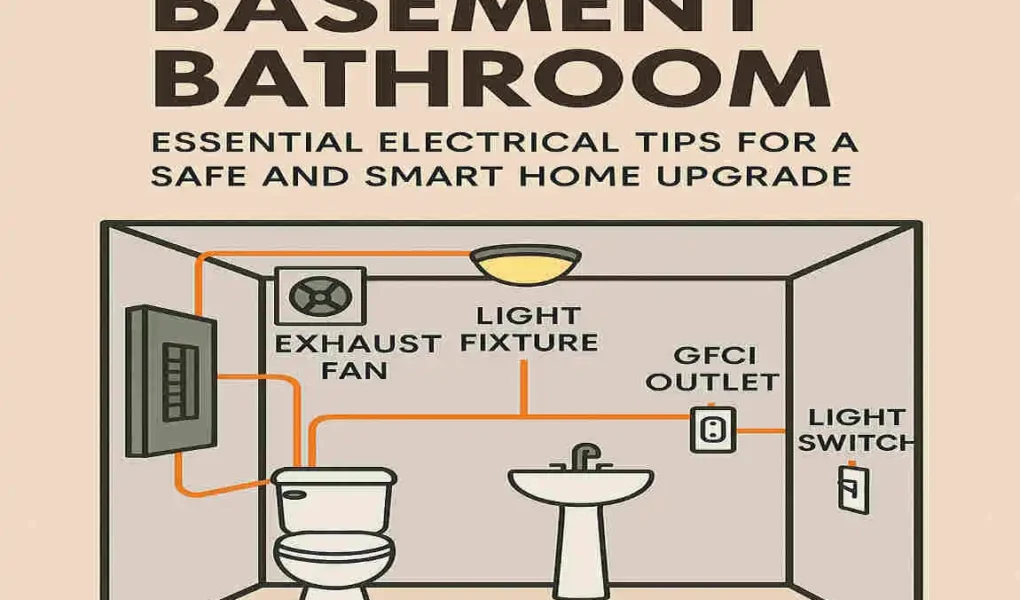Are you thinking about adding a bathroom to your basement? That’s a fantastic way to increase your home’s value and comfort. But before you start, it’s crucial to understand how to wire a basement bathroom properly. Proper electrical wiring is essential for safety, code compliance, and to enjoy the benefits of a smart home upgrade.
Understanding Basement Bathroom Wiring Basics

What Makes Basement Bathroom Wiring Unique?
Wiring a basement bathroom comes with its own set of challenges and considerations. Here’s what sets it apart:
- Moisture concerns and waterproofing: Basements are prone to moisture, which can pose a significant issue for electrical systems. Proper waterproofing and moisture-resistant materials are crucial.
- Limited natural light and ventilation: Unlike upstairs bathrooms, basements often lack natural light and ventilation. This means you’ll need to plan for adequate lighting and ventilation systems.
Basic Electrical Components Needed
To wire your basement bathroom, you’ll need several key electrical components:
- Circuit breakers and panels: These are the heart of your electrical system, controlling the flow of electricity to your bathroom.
- Ground fault circuit interrupters (GFCIs): These devices protect against electrical shock by quickly interrupting power if they detect a ground fault. We’ll explain GFCI in more detail later.
- Switches, outlets, lighting fixtures, and ventilation fans: These are the everyday components you’ll need to install in your bathroom.
Relevant Electrical Codes and Permits
Before you start any electrical work, it’s essential to understand the relevant codes and obtain the necessary permits:
- Overview of NEC (National Electrical Code) requirements for bathrooms: The NEC sets the standard for electrical installations in the United States. It includes specific requirements for bathrooms, such as GFCI protection and proper grounding.
- Special considerations for basement installations: Basements often have unique requirements, such as dealing with moisture and limited access to electrical panels.
- Importance of obtaining necessary permits before starting work: Permits ensure your work complies with local codes and regulations. They also protect you from potential legal issues down the road.
Planning Your Basement Bathroom Electrical Layout
Assessing Power Needs and Load Calculations
Before you start wiring, you need to assess your basement bathroom’s power needs:
- Estimating wattage for lights, outlets, fans, heaters: Calculate the total wattage required for all your bathroom appliances and fixtures.
- Planning for future upgrades and smart appliances: Consider your long-term goals and plan for potential upgrades, such as bright lighting or heated floors.
Designing the Circuit Layout
Once you’ve assessed your power needs, it’s time to design your circuit layout:
- Dedicated circuits for bathroom appliances: Certain appliances, like heaters or whirlpool tubs, may require dedicated circuits to prevent overloading.
- GFCI protection for all outlets and water-prone areas: As mentioned earlier, GFCI protection is crucial in bathrooms to avoid electrical shocks.
- Placement tips for lights, outlets, and switches: Consider your bathroom layout and place electrical components for optimal convenience and safety.
Creating a Wiring Diagram
A wiring diagram is a crucial tool for planning and executing your electrical work:
- Step-by-step guide to drawing a wiring plan: We’ll walk you through creating a clear, accurate wiring diagram.
- Recommended tools and apps for electrical planning: We’ll suggest some helpful tools and apps to make the planning process more manageable.
Step-by-Step Guide on How to Wire a Basement Bathroom
Safety First: Tools and Personal Protective Equipment (PPE)
Before you start any electrical work, it’s crucial to prioritize safety:
- Essential tools for the job: We’ll list the tools you’ll need, such as wire strippers, voltage testers, and screwdrivers.
- Personal protective equipment (PPE): We’ll discuss the importance of wearing appropriate PPE, such as gloves and safety glasses.
Turning Off the Power and Testing Circuits
Before you start working on any electrical components, you must turn off the power and test the circuits:
- How to safely turn off power to your basement: We’ll guide you through locating your main electrical panel and turning off the appropriate breakers.
- Using a voltage tester to ensure the power is off: We’ll explain how to use one to double-check that the power is off before you start working.
Running Electrical Wires
Once you’ve ensured the power is off, it’s time to start running your electrical wires:
- Choosing the right type and gauge of wire: We’ll discuss the different types of wire and help you choose the right one for your basement bathroom.
- Best practices for drilling and protecting wires in basement walls: We’ll provide tips for safely running wires through your basement walls, including how to protect them from damage.
Installing Electrical Boxes
Electrical boxes are essential for housing your outlets, switches, and other components:
- How to mount boxes and ensure proper spacing: We’ll guide you through mounting electrical boxes and ensuring they’re properly spaced per code.
- Tips for working with different types of basement walls: We’ll discuss how to work with concrete and drywall basement walls.
Connecting GFCI Outlets and Switches
GFCI protection is crucial in bathrooms, so we’ll walk you through the process of connecting these devices:
- Step-by-step wiring instructions for GFCI outlets and switches: We’ll provide detailed instructions, including diagrams and photos.
- Testing GFCI outlets for functionality: We’ll explain how to test your GFCI outlets to ensure they’re working correctly.
Wiring Lighting Fixtures and Exhaust Fans
Proper lighting and ventilation are essential in a basement bathroom:
- Proper fixture mounting and wiring tips: We’ll discuss how to mount and wire your lighting fixtures and exhaust fans safely and efficiently.
- Integrating energy-efficient LED lights: We’ll provide tips for choosing and installing energy-efficient LED lighting in your basement bathroom.
Grounding and Bonding Explained
Grounding and bonding are critical for safety and code compliance:
- Essential steps for grounding for safety and code compliance: We’ll explain the importance of proper grounding and provide step-by-step instructions to ensure your basement bathroom is adequately grounded.
Tips for a Smart and Energy-Efficient Basement Bathroom

Integrating Smart Switches and Outlets
Innovative technology can make your basement bathroom more convenient and energy-efficient:
- Benefits of smart controls for lighting and ventilation: We’ll discuss how smart switches and outlets can improve your bathroom’s functionality and energy efficiency.
- How to retrofit smart devices into existing wiring: We’ll provide tips for integrating them into your electrical system.
Choosing Energy-Efficient Fixtures and Appliances
Energy-efficient fixtures and appliances can help you save money and reduce your environmental impact:
- LED lighting options and moisture-resistant fans: We’ll discuss the best energy-efficient lighting and ventilation options for your basement bathroom.
- Tips for choosing energy-efficient appliances: We’ll provide guidance on selecting efficient toilets and sinks.
Installing Motion Sensors and Timers
Motion sensors and timers can improve convenience and reduce energy usage:
- How these improve convenience and reduce energy usage: We’ll explain how motion sensors and timers work and how they can benefit your basement bathroom.
- Tips for installing and programming these devices: We’ll provide step-by-step instructions for installing and programming motion sensors and timers.
Considerations for Future-Proofing Your Bathroom Wiring
To ensure your basement bathroom remains functional and up-to-date, consider future-proofing your wiring:
- Planning for future upgrades and innovative technology: We’ll discuss how to plan your wiring to accommodate future upgrades and smart devices.
- Tips for making your wiring adaptable and expandable: We’ll provide guidance on making your wiring system flexible and easy to modify.
Common Mistakes to Avoid When Wiring a Basement Bathroom
When wiring a basement bathroom, it’s essential to avoid these common mistakes:
- Ignoring local electrical codes and permits: Failing to comply with local codes and obtain required licenses can pose safety hazards and legal issues.
- Failing to use GFCI protection properly: GFCI protection is crucial in bathrooms, and failing to use it correctly can put you and your family at risk of electrical shocks.
- Skipping the grounding process: Proper grounding is essential for safety and code compliance —don’t skip this crucial step.
- Overloading circuits and improper load calculation: Overloading circuits can lead to tripped breakers, damaged appliances, and even fires, so make sure to calculate your load correctly.
- Poor wire management and inadequate box placement: Improper wire management and box placement can make your electrical system difficult to maintain and potentially hazardous.
- Not testing work thoroughly before finishing walls: Always test your work before finishing walls to ensure everything is functioning correctly and safely.
When to Hire a Professional Electrician
While many aspects of wiring a basement bathroom can be DIY-friendly, there are situations where it’s best to hire a professional electrician:
- Identifying complex or hazardous situations: We’ll discuss how to recognize when a project is beyond your skill level or too hazardous to tackle on your own.
- Benefits of professional inspections and final approvals: A professional electrician can ensure your work meets all codes and standards, providing peace of mind and protecting your investment.
- Cost considerations vs. DIY risks: We’ll compare the costs of hiring a professional with the potential risks and expenses of DIY mistakes.
- How to find a licensed electrician with bathroom wiring experience: We’ll provide tips for finding and hiring a qualified electrician for your basement bathroom project.




